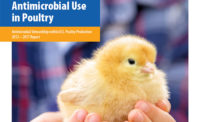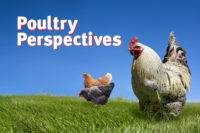Poultry Perspectives
Compartmentalization of the poultry primary breeding industry

U.S. Avian Influenza Clean Compartment
One of the many effects of our recent experiences with highly pathogenic avian influenza (HPAI) has been the difficulties that the primary breeding industry in the U.S. has had in exporting its products and also moving breeding stock within the United States. Approximately 60 percent of the genetic stock for all segments of the global poultry industry originates in the U.S. The disruption in global and interstate trade of genetic stock has had important consequences for the primary breeding companies and their international customers. As a result, efforts to compartmentalize the primary breeding industry have gained new urgency.
So, what is compartmentalization? There are two concepts that are often confused: regionalization and compartmentalization. Regionalization is a procedure that may be implemented by a country to manage populations of animals confined to a distinct geographical region within its territory for the purposes of disease control and international trade. For example, regionalization was accepted by some countries in 2015 during our HPAI outbreak, and those countries placed trade embargoes only on those states within which there were infected flocks.
Compartmentalization, on the other hand, is very different. It is a procedure that may be implemented by a country to define and manage animal subpopulations of distinct health status and common biosecurity program within its territory for the purpose of disease control and international trade. In this case, the animal subpopulation is primary breeding stock. The distinct health status is that they are free of H5/H7 avian influenza virus (HPAI) and the biosecurity program is one that is specifically designed to prevent introduction of HPAI.
USPOULTRY was asked to help develop documents required to establish a primary breeder compartmentalization program in the U.S. Working alongside the staff of the National Poultry Improvement Plan (NPIP), the staff of the National Import Export Service (NIES) and the primary breeding companies, USPOULTRY was able to help create and submit a proposal to USDA for a primary breeder compartmentalization program.
Many things were considered in the development of this program. It complies with all guidelines of the OIE (World Organization for Animal Health) and all requirements of the U.S. Code of Federal Regulations. When established, it will become part of the NPIP program and will be administered by NPIP staff.
The proposal focuses on prevention of the introduction of H5/H7 avian influenza virus through the development of a detailed biosecurity program. It recognizes the particular methods of introduction and spread of avian influenza virus and does not specifically attempt to prevent the introduction of other pathogens, although the program should provide enhanced biosecurity against all poultry pathogens.
The focus is on the control of access and movement of wild and domestic birds, people, vehicles, equipment, materials and supplies, pests and wildlife. It takes advantage of current avian influenza control and monitoring programs without creating redundant or conflicting new programs. It provides guidelines that allow primary breeding companies to apply practical modern poultry production practices to accomplish the requirements of the guidelines.
The facilities and management programs of each primary breeding company are all excellent but vary in detail. The compartmentalization guidelines are adaptable to the specific details of each company’s existing programs.
How will the process work? USDA has published the proposal for public comment. Following the comment period and consideration of comments, the program will become part of the NPIP Program Standards. At that point, primary breeding companies can apply to be a U.S. Avian Influenza Clean Compartment.
The application is very detailed and will be thoroughly audited. Certified auditors for the compartmentalization program will be trained in NPIP compartmentalization auditor workshops. Compliance will be ensured by ongoing audits on an established timeline. Once a company is approved as a compartment, NIES staff will start the process of working with international trading partners to accept the company’s status as a U.S. Avian Influenza Clean Compartment. Acceptance of this status by a country should greatly facilitate the exportation of genetic stock to that country during an HPAI outbreak in the U.S. Likewise, establishment of primary breeding companies as U.S. Avian Influenza Clean Compartments will allow interstate commerce involving poultry breeding stock to continue during a HPAI outbreak in the U.S.
As with all NPIP programs, the compartmentalization program is expected to become the global gold standard. The practical nature and thorough detail in the compartmentalization program is another great example of how the poultry industry and the USDA can work together to create something valuable for the poultry industry, the consumer and global trade. NP
Looking for a reprint of this article?
From high-res PDFs to custom plaques, order your copy today!





